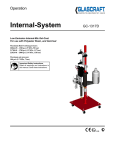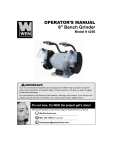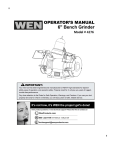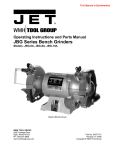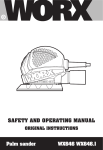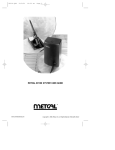Download Argos PGF105P Instruction manual
Transcript
105W PALM SANDER INSTRUCTION MANUAL PGF105P Original instructions GENERAL POWER TOOL SAFETY WARNINGS WARNING! Read all safety warnings and all instructions. Failure to follow the warnings and instructions may result in electric shock, fire and/or serious injury. Save all warnings and instructions for future reference. The term “power tool” in the warnings refers to your mains-operated (corded) power tool or battery-operated (cordless) power tool. 1) Work area safety a) Keep work area clean and well lit. Cluttered or dark areas invite accidents. b) Do not operate power tools in explosive atmospheres, such as in the presence of flammable liquids, gases or dust. Power tools create sparks which may ignite the dust or fumes. c) Keep children and bystanders away while operating a power tool. Distractions can cause you to lose control. 2) Electrical safety a) Power tool plugs must match the outlet. Never modify the plug in any way. Do not use any adapter plugs with earthed (grounded) power tools. Unmodified plugs and matching outlets will reduce risk of electric shock. b) Avoid body contact with earthed or grounded surfaces, such as pipes, radiators, ranges and refrigerators. There is an increased risk of electric shock if your body is earthed or grounded. c) Do not expose power tools to rain or wet conditions. Water entering a power tool will increase the risk of electric shock. d) Do not abuse the cord. Never use the cord for carrying, pulling or unplugging the power tool. Keep cord away from heat, oil, sharp edges or moving parts. Damaged or entangled cords increase the risk of electric shock. e) When operating a power tool 2 outdoors, use an extension cord suitable for outdoor use. Use of a cord suitable for outdoor use reduces the risk of electric shock. f) If operating a power tool in a damp location is unavoidable, use a residual current device (RCD) protected supply. Use of an RCD reduces the risk of electric shock. 3) Personal safety a) Stay alert, watch what you are doing and use common sense when operating a power tool. Do not use a power tool while you are tired or under the influence of drugs, alcohol or medication. A moment of inattention while operating power tools may result in serious personal injury. b) Use personal protective equipment. Always wear eye protection. Protective equipment such as dust mask, nonskid safety shoes, hard hat, or hearing protection used for appropriate conditions will reduce personal injuries. c) Prevent unintentional starting. Ensure the switch is in the off-position before connecting to power source and/ or battery pack, picking up or carrying the tool. Carrying power tools with your finger on the switch or energising power tools that have the switch on invites accidents. d) Remove any adjusting key or wrench before turning the power tool on. A wrench or a key left attached to a rotating part of the power tool may result in personal injury. e) Do not overreach. Keep proper footing and balance at all times. This enables better control of the power tool in unexpected situations. f) Dress properly. Do not wear loose clothing or jewellery. Keep your hair, clothing and gloves away from moving parts. Loose clothes, jewellery or long hair can be caught in moving parts. g) If devices are provided for the connection of dust extraction and collection facilities, ensure these are HELPLINE NO 08448012949 Original instructions connected and properly used. Use of dust collection can reduce dust-related hazards. 4) Power tool use and care a) Do not force the power tool. Use the correct power tool for your application. The correct power tool will do the job better and safer at the rate for which it was designed. b) Do not use the power tool if the switch does not turn it on and off. Any power tool that cannot be controlled with the switch is dangerous and must be repaired. c) Disconnect the plug from the power source and/or the battery pack from the power tool before making any adjustments, changing accessories, or storing power tools. Such preventive safety measures reduce the risk of starting the power tool accidentally. d) Store idle power tools out of the reach of children and do not allow persons unfamiliar with the power tool or these instructions to operate the power tool. Power tools are dangerous in the hands of untrained users. e) Maintain power tools. Check for misalignment or binding of moving parts, breakage of parts and any other condition that may affect the power tool’s operation. If damaged, have the power tool repaired before use. Many accidents are caused by poorly maintained power tools. f) Keep cutting tools sharp and clean. Properly maintained cutting tools with sharp cutting edges are less likely to bind and are easier to control. g) Use the power tool, accessories and tool bits etc. in accordance with these instructions, taking into account the working conditions and the work to be performed. Use of the power tool for operations different from those intended could result in a hazardous situation. 5) Service a) Have your power tool serviced by a qualified repair person using only identical replacement parts. This will ensure that the safety of the power tool is maintained. b) If the replacement of the supply cord is necessary, this has to be done by the manufacturer or his agent in order to avoid a safety hazard. ADDITIONAL SAFETY INSTRUCTIONS FOR YOUR SANDER 1. Harmful/toxic dusts will arise from sanding e.g. lead painted surfaces, woods and metals. Contact with or inhalation of these dusts can endanger the health of operator and bystanders. Always use eye glasses and dust mask. 2. Hearing protection should be worn when using the sander. 3. Hold power tools by insulated gripping surfaces when performing an operation where the cutting tool may contact hidden wiring or its own cord. Contact with a” live” wire will make exposed metal parts of the tool” live” and shock the operator 4. Always wear safety glasses or eye shields when using the sander. Everyday eyeglasses have only impactresistant lenses; they are not safety glasses. Following this rule will reduce the risk of serious personal injury. 5. Remove the plug from the socket before carrying out any adjustment, servicing or maintenance. 6. Fully unwind cable drum extensions to avoid potential overheating. 7. When an extension cable is required you must ensure it has the correct ampere rating for your power tool and is in a safe electrical condition. 8. Ensure your mains supply voltage is same as indicated on the rating plate. 9. Your tool is double insulated for additional protection against a possible electrical insulation failure within the tool. 10. Always check walls, floors and ceilings HELPLINE NO 08448012949 3 Original instructions to avoid hidden power cables and pipes. 11. After long working periods external metal parts and accessories could be hot. 12. If possible, ensure the work-piece is firmly clamped to prevent movement. 13. Your sander is a hand held tool, do not clamp your sander. 14. Before sanding, check the area is free of nails, screws, etc. 15. Never stop the sander by applying a force to the base plate. 16. Only use paper in good condition. Do not use torn or worn paper. 17. Do not sand material containing asbestos due to a health risk. 18. Do not sand lead based paint due to the risk of lead poisoning. 19. Do not eat or drink in the working area of the sander. 20. Do not allow people to enter the working area without wearing a dust mask. 21. Where possible, seal off the working area to contain the dust for later removal. 22. Your tool is designed for dry sanding only, not wet sanding. 23. Your tool is designed for general purpose light polishing of wood and metals. 24. Do not sand magnesium material due to the risk of fire. WARNING: Some dust particles created by power sanding, contain chemicals known to cause cancer, birth defects or other reproductive harm. Some examples of these chemicals are: • Lead from lead-based paints. • Crystalline silica from bricks and cement and other masonry products. • Arsenic and chromium from chemically treated lumber. Your risk from these exposures varies, depending upon how often you do this type of work. To reduce your exposure to these chemicals: • Work in a well-ventilated area. • Work with approved safety equipment, such as those dust masks that are specially designed to filter microscopic particles. 4 Symbols To reduce the risk of injury, user must read instruction manual Warning Double insulation Wear eye protection Wear ear protection Wear dust mask Waste electrical products should not be disposed of with household waste. Please recycle where facilities exist. Check with your Local Authority or retailer for recycling advice. HELPLINE NO 08448012949 OrIgINaL INstructIONs 1 2 5 4 3 cOMPONENt LIst 1. Handle 2. On/off switch 3. Sanding pad 4. Sanding paper 5. Vacuum adaptor accEssOrIEs 1pc 2pcs 2pcs 1pc Vacuum adaptor 32mm 60grit sanding papers 80grit sanding papers 100grit sanding paper We recommend that you purchase your accessories from the same store that sold you the tool. Use good quality accessories marked with a well-known brand name. Choose the type according to the work you intend to undertake. Refer to the accessory packaging for further details. Store personnel can assist you and offer advice. HELPLINE NO 08448012949 5 TECHNICAL DATA Original instructions 230-240V~50Hz 105W 13000min-1 140x140x80mm 1.4mm /II 0.9kg Voltage Power input No load speed Diameter of base Orbital dia Protection class Machine weight NOISE INFORMATION A weighted sound pressure A weighted sound power KPA & KWA Wear ear protection when sound pressure is over LPA:81dB(A) LWA:92dB(A) 3.0dB(A) 85dB(A) VIBRATION INFORMATION Vibration total values (triax vector sum) determined according to EN 60745: Vibration emission value ah = 2.93m/s² Uncertainty K = 1.5m/s² WARNING: The vibration emission value during actual use of the power tool can differ from the declared value depending on the ways in which the tool is used dependant on the following examples and other variations on how the tool is used: The tool being in good condition and well maintained. The use the correct accessory for the tool and ensuring it is sharp and in good condition. The tightness of the grip on the handles and if any anti vibration accessories are used. And the tool is being used as intended by its design and these instructions. This tool may cause hand-arm vibration syndrome if its use is not adequately managed. WARNING: To be accurate, an estimation of exposure level in the actual conditions of use should also take account of all parts of the operating cycle such as the times when the tool is switched off and when it is running idle but not actually doing the job. This may significantly reduce the exposure level over the total working period. Helping to minimise your vibration exposure risk. Maintain this tool in accordance with these instructions and keep well lubricated (where appropriate). If the tool is to be used regularly then invest in anti vibration accessories. Avoid using tools in temperatures of 10oC or less. Plan your work schedule to spread any high vibration tool use across a number of days. 6 HELPLINE NO 08448012949 Original instructions OPERATING INSTRUCTIONS 3. OPERATING THE SWITCH (See Fig C) NOTE: Before using the tool, read the instruction book carefully. 1. FITTING THE SANDING PAPER (See Fig A) 2 Fig.C To operate the sander, plug into mains (make sure switch is in switch off position first). Grip sander firmly and switch on. Depress the switch (2) to start or stop your palm sander. Fig.A Fit the paper over the pad so that it covers the entire area. Make sure the sanding paper is even with the edges and that the dust collection holes in the pad and sanding paper is aligned and the sanding paper evenly overlaps the pad. Never use your sander without a sanding paper. 2. USING THE VACUUM ADAPTER (See Fig B) 4. USING THE SANDER Your sander is equipped with a teardrop base which allows you to use it on large flat surfaces, as well as difficult and confined areas. The workpiece to be sanded must be secured. If it is small or it may move during sanding, it must be held in a vice or suitably clamped. Be sure to hold the sander firmly while it is on and apply it gently to the work, it may “kick” on first contact. Hold the sander so that it is flat on the work and move slowly, preferably with a smooth, circular motion. Regularly check the condition of the sanding paper and replace when worn for best results. Fig.B Your sander is equipped with a vacuum adapter, which is designed for collect dust task. Insert the vacuum adapter into the rear dust outlet of sander. Then pull the vacuum adapter and make sure it is tightened securely on the dust outlet. See Fig B. Then connect the hose of a vacuum cleaner. First please turn on the vacuum cleaner, then turn on the sander. If you stop sanding, first turn off the sander, then turn off your vacuum cleaner. WORKING HINTS FOR YOUR SANDER 1. Your sander is useful for working on wood, metal, painted surface. It will smooth surfaces prior to painting, even where fillers have been used and left proud. 2. Your sander is best suited to large flat areas such as doors but can also be used on skirting boards, windows, etc, provided they are accessible. HELPLINE NO 08448012949 7 Original instructions 3. Different types of sanding paper will allow the sander to meet various needs. Different grades of sanding paper are available, the higher grit number, the finer the grit. For rough work start with a low grit (i.e. 80 grit) and change to a higher, finer grit (i.e. 100 grit or 120 grit) for finishing. If you use a fine grit for rough surfaces it will soon clog and need changing. 4. At all times, let the sander do the workdo not force it or apply excessive pressure to the sanding paper or it could wrinkle or tear. Preferably, use a light circular motion. 5. If the surface shows excessive making from the abrasive motion, you may be using a grit which is too coarse or applying too much pressure. become damp, the abrasive particles will lose their adhesion to the backing paper and will not abrade. 3. If the sander dose not move smoothly, The sanding paper may be loose, damaged or wrinkled. Replace and try again. 4. If a fault can not be rectified return the sander to an authorized dealer for repair. MAINTENANCE Remove the plug from the socket before carrying out any adjustment, servicing or maintenance. Your power tool requires no additional lubrication or maintenance. There are no user serviceable parts in your power tool. Never use water or chemical cleaners to clean your power tool. Wipe clean with a dry cloth. Always store your power tool in a dry place. Keep the motor ventilation slots clean. Keep all working controls free of dust. If the supply cord is damaged, it must be replaced by the manufacturer, its service agent or similarly qualified persons in order to avoid a hazard. TROUBLESHOOTING 1. If your sander will not operate, check the power at the mains plug. 2. If the sander does not abrade surface, checking the sanding paper. If the sanding paper has been worn, replace the new paper and try again. The paper must be kept in a dry place, if it is allowed to 8 HELPLINE NO 08448012949 Original instructions PLUG REPLACEMENT Your Power Tool is supplied with a fitted plug, however if you need to fit a new plug follow the instruction below. IMPORTANT The wires in the mains lead are coloured in accordance with the following code: Blue = Neutral Brown = Live As the colours of the wires in the mains lead of this appliance may not correspond with the coloured markings identifying the terminals in your plug, proceed as follows: The wire which is coloured blue must be connected to the terminal which is marked with N. The wire which is coloured brown must be connected to the terminal which is marked with the letter L. If a 13 AMP (BS 1363/A) Plug is used, a 13 AMP Fuse must be fitted, or if any other type of plug is used a 13 AMP Fuse must be fitted, either in the Plug or Adaptor, or on the Distribution Board. Note: If a moulded plug is fitted and has to be removed take great care in disposing of the plug and severed cable, it must be destroyed to prevent engaging into a socket. If the supply cord is damaged it must be replaced by a service agent or a similarly qualified person in order to avoid hazard. HELPLINE NO 08448012949 9 ENVIRONMENTAL PROTECTION Waste electrical products should not be disposed of with household waste. Please recycle where facilities exist. Check with your Local Authority or retailer for recycling advice. If faults can not be remedied, contact the Helpline on 08448012949 GUARANTEE This product is selected for DOMESTIC USE ONLY and not for business use. This product is guaranteed against manufacturing defects for a period of 12 months This does not cover the product where the fault is due to misuse, abuse, use in contravention of the instructions, or where the product has been the subject of unauthorised modifications or alterations, or has been the subject of commercial use. In the event of a problem with the product within the guarantee period please return it to your nearest Argos store. If the item is shown to have an inherent defect present at the time of sale, the store will provide you with a replacement Your statutory rights remain unaffected. Guarantor: Home Retail Group, MK9 2NW Issue2 10/2009











